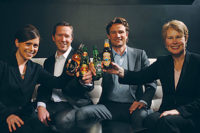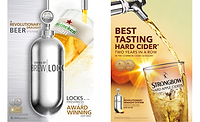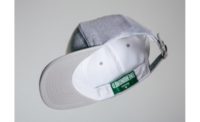This year’s acquisition of Fomento Económico Mexicano S.A.B. de C.V.’s (CCM) beer operations by Heineken N.V., Amsterdam, is described as a love story within a business context by John Nicolson, New York-based Heineken Americas’ regional president.
The two beer companies established a relationship in the United States in 2004 in which Heineken USA was the sole and exclusive importer, marketer and seller of CCM’s beer in the United States. The agreement included CCM’s Dos Equis, Tecate, Tecate Light, Sol, Carta Blanca and Bohemia brands. The initial three-year contract was extended in 2007 with a 10-year agreement between the two beer companies.
Despite the long-standing partnership, Heineken was not the only suitor in the bid to acquire CCM. “I said at the [Heineken] national distributors conference that I felt that CCM had been my girlfriend for a couple years and basically this other guy came on the block and was trying to steal my girl away,” Nicolson says. “Finally, true love came through, and we actually got married. That, to me, was the best analogy because we could have lost it.”
The acquisition added an element of longevity to the established relationship between Heineken and the CCM brands in the United States.
“In the U.S., after the acqusition, the brands are back at home,” Nicolson says. “There are no longer contractual relationships so, in the future, we will follow the same strategic decisions, but marginally different because now we have full sight of where the profitability is, which we didn’t have before, so that’s a positive thing for the U.S. market.”
Heineken USA reports to Heineken Americas, which encompasses North and South America and the Caribbean. While the geographic boundaries of the Americas territory remain the same after the CCM acquisition, the business’s impact has increased. In 2008 in the region, Heineken USA sold approximately 7.6 million hectoliters (88.5 million cases) of Heineken-based product, which includes Heineken, Heineken Premium Light, Amstel Light and Newcastle Brown Ale, Nicolson says. Sales of CCM’s brands contributed about 3 million hectoliters.
“The CCM business in the U.S. was just a bit short of 30 percent of Heineken USA’s business before the acquisition,” Nicolson says. “In essence, it owns its future now, whereas before, part of the business was under license. People might argue that we’re more confident about what we do now, but essentially we’re not changing the strategy on [the CCM] brands because the team has done a great job.”
Foreign exchange
The combination of Heineken and CCM grows the company’s reach beyond the United States and into emerging markets in South America. Across the entire beer industry, North and South America represents more than half of the profit pool, Nicolson says. For Heineken, the Americas region contributes to 25 percent of company profits as Heineken’s business has strengths in Europe, Asia and Africa, he says.
Heineken’s Americas region is divided into six territories: the United States, Mexico, the Caribbean, Brazil and the company’s joint ventures in Central America and in Argentina and Chile.
“[The Americas region is] a very, very positive region and the people have a very positive outlook on life,” Nicolson says. “I think it’s a great place to be. This region is a big region and it’s an important region for the future with a large population of future consumers, political stability and continued gross domestic product growth – all of which are key for beer growth.”
In addition to an increased presence in the Americas, Heineken also has the opportunity to market CCM’s beer brands in the global market, Nicolson says.
“The export department at CCM has done a great job in the U.S., but it was largely operating through other businesses in every other market in the world and now it’s part of the Heineken network,” he says.
Overall, the acquisition provides Heineken with more exposure in North and South America and a global distribution network for CCM’s brands.
“I look at where we were two years ago in the region, we had businesses in all the Caribbean islands and Central America with Heineken, but we were still a relatively small player in the Americas and an import business in North America,” Nicolson says. “With this acquisition, the Mexico operation itself is Heineken’s biggest country-specific operation worldwide. It’s changed the whole company because we have another 23,000 employees from Mexico and we have a very big business in Brazil as well. Those two components have fundamentally changed the scale of the businesses plus the influx of new employees.”
‘Interesting’ brand strategy
Heineken USA’s marketing strategy across its entire portfolio strives to “constantly delight consumers in unexpected ways at unexpected times and have them experience our brands,” says Tara Carraro, senior director of corporate communications for Heineken USA.
Arguably the portfolio’s model marketed brand recently has been Dos Equis, which has posted 24 percent year-to-date increases, according to Nielsen data cited by Heineken USA’s Dos Equis Brand Director Paul Smailes. Dos Equis has leveraged the strength of its “The Most Interesting Man in the World” campaign without overexposing the elusive character, Smailes says
“‘The Most Interesting Man in the World’ represents an aspirational icon for our consumers,” he says. “He and the brand share a similar philosophy on life, but he’s not the spokesman of the brand. Because of his mysterious and intriguing character, we feel it’s best that we don’t use him on every single touch point. The brand proposition of wanting to live a more interesting life is brought to life through different marketing programs and initiatives, so really the brand proposition is still very consistent and is supported in different ways.”
In addition to leveraging “The Most Interesting Man in the World,” Dos Equis has taken the “interesting” proposition and used it as inspiration for on-premise sampling, event sponsorship and special programs, such as this fall’s return of “The Most Interesting Show in the World.” Designed as an upscale variety show, “The Most Interesting Show in the World” visited 17 cities across the United States from Oct. 5 to Nov. 3. The show was designed to be an immersive experience for attendees, Smailes says, and featured illusionists, burlesque dancers and other unique talents and was hosted by musician Andrew W.K.
Eleven core markets are leading Dos Equis’ growth and next year’s strategy includes maintaining growth trends in those markets, but also accelerating the brand in markets with potential for high volume, Smailes says.
Within the Heineken USA portfolio, the success of the Dos Equis campaign serves as inspiration, Nicolson says.
“In our portfolio the best advertising is on Dos Equis,” he says. “I’d like the Heineken team to beat the Dos Equis team. Heineken in the U.S. is performing better than it has in some time, but what they talk about in marketing is that you’re only as good as your last result, we just have to get the Dos Equis style on everything else. That will help reinforce our brands’ position with their loyal consumer following in the U.S.”
Authentic emphasis
Individually, Heineken’s brands are addressing market trends and tapping into their particular strengths and consumer preferences.
For the flagship Heineken brand, packaging has helped “innovate, delight and add value to the Heineken experience,” says Filip Wouters, vice president of marketing for Heineken USA. Heineken built on the brand’s DraughtKeg and BeerTender innovations and unveiled its STR glow-in-the-dark aluminum bottle this fall.
“The STR bottle leverages a fusion of sophistication and progressive European design to reinforce the brand’s innovative, stylish appearance, which is extremely relevant in today’s high-end nightclubs,” Wouters says.
The STR bottle has a modern European design with a silver and green color scheme when seen in daylight, but under a blacklight the bottle reveals a pattern of stars and trails. The bottle was launched in limited distribution in exclusive nightclub locations to further the Heineken brand experience, Wouters says.
Heineken Premium Light launched a campaign this year to encourage consumers to “See the Light.” The campaign urges consumers to move beyond their old ways of thinking and live a “stepped up life,” which includes lifestyle changes as well as taking their light beer choices to the next level, Wouters says.
“Every day, our consumers have a choice to give up on their old ways of doing things and embrace what’s next – better relationships, more interesting friends, new styles of clothes,” he says. “We see Heineken Light as the beer for those who enjoy the good life with a light and refreshing beer that has more depth.”
Making an appropriate light beer choice also is the focus for the marketing of CCM brand Tecate Light. The light beer’s campaign features Spanish-language advertising in which Latino parents lament that their adult son, who has moved to the United States, sends letters home with photos of himself drinking light beer. The campaign is focused primarily in California and Texas markets and plays on cultural nuances, emphasizing, “If you’re going to drink light beer, drink Tecate Light,” Nicolson says.
European import brands, Amstel Light and Newcastle Brown Ale, leverage their heritage as part of their marketing. For the past two years, Amstel Light has leveraged the Amsterdam heritage of its brand, says Amanda Hawk, Heineken USA’s brand director for Amstel Light.
“The campaign is a rallying cry for loyal consumers who’ve savored Amstel Light for years, as well as an introduction for new consumers to the brand’s quality, authenticity and Amsterdam-based brewing tradition,” Hawk says.
Newcastle Brown Ale also found the authentic experience is important to its core consumers. Known as “The One and Only,” the brand leveraged its heritage with a special promotion featuring specially designed glassware, called the Geordie Schooner. The glass is the brand’s traditional serving piece in Newcastle, England.
Despite a small heritage angle, Newcastle is not about being British for British sake, says Colin Westcott-Pitt, Heineken USA’s vice president of marketing for Dos Equis, Amstel Light and Newcastle Brown Ale. One demographic of growth for the brand is craft beer consumers, Westcott-Pitt says.
“One of the core elements of the Newcastle brand is that it’s an import that acts like a craft,” he says. “The craft consumer is looking for a sense of exploration and individuality. In the Newcastle taste profile, consumers have a dark beer that’s easy to drink. This has made it a favorite among young guys who like being seen with dark beers, but who do not like the more challenging hop tastes that some crafts deliver.”
The brand tested Newcastle Brown Ale in DraughtKeg packaging and a seasonal Newcastle Summer Ale variety this year.
“Those two test products have moved from limited tests to broader distribution this year, with strong reception by our target consumer,” Westcott-Pitt says. “These innovations are helping to provide greater insight into consumer preferences, which will, in turn, help the Newcastle brand continue to grow in this market.” BI
Get our new eMagazine delivered to your inbox every month.
Stay in the know on the latest beverage industry marketplace trends.
SUBSCRIBE TODAY!Copyright ©2024. All Rights Reserved BNP Media.
Design, CMS, Hosting & Web Development :: ePublishing


